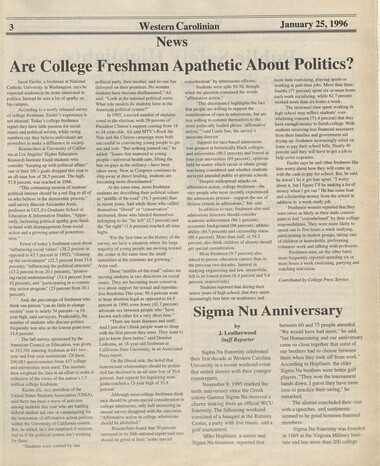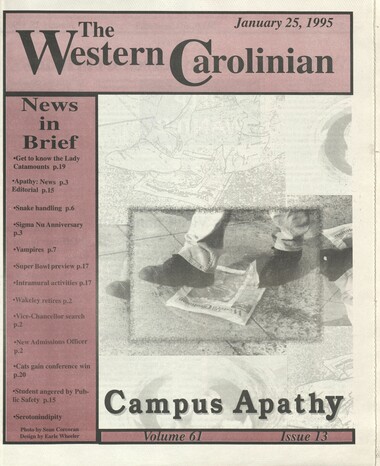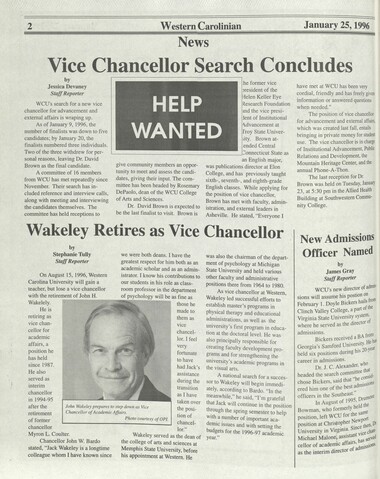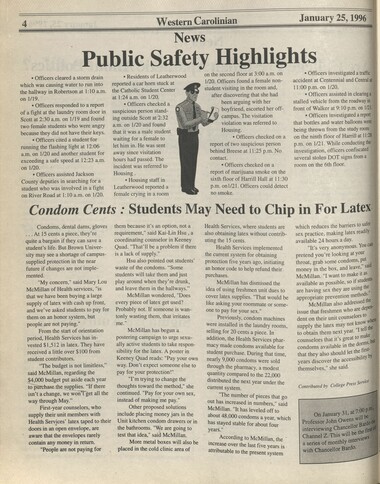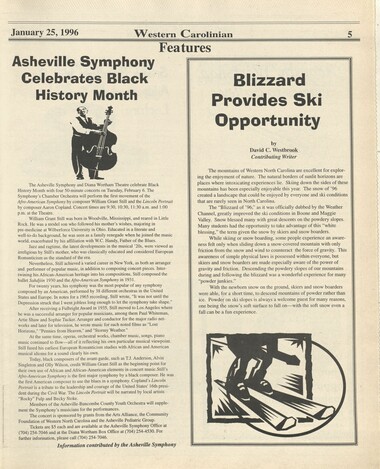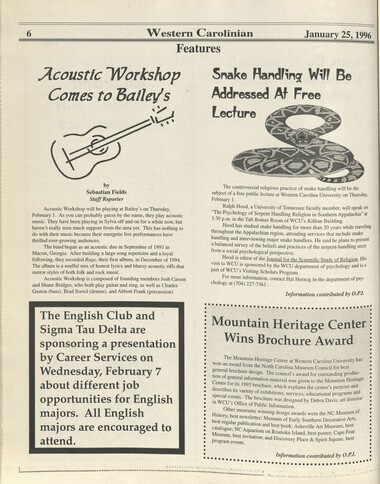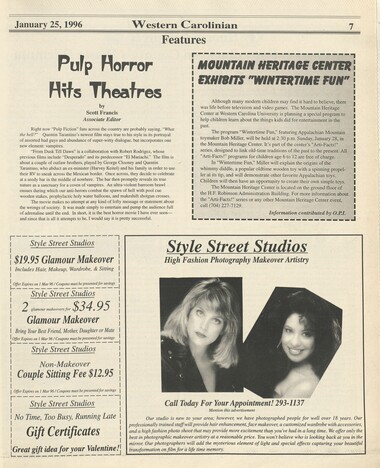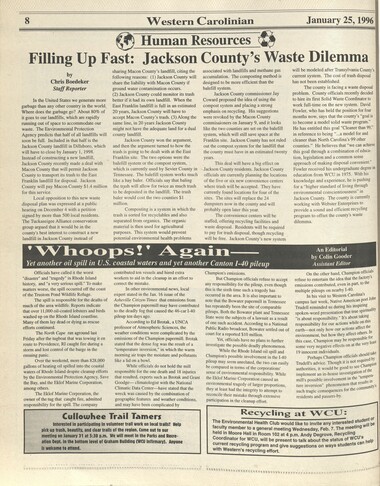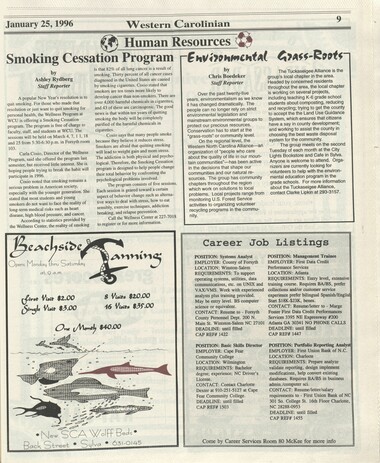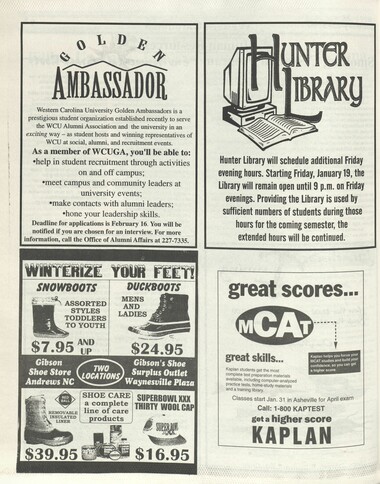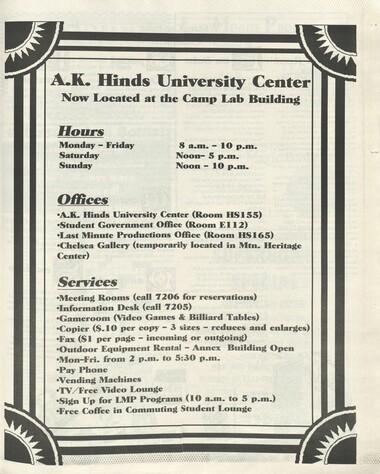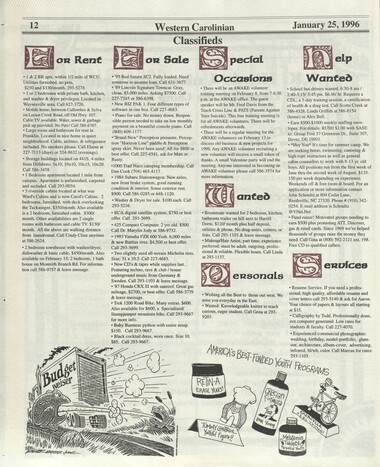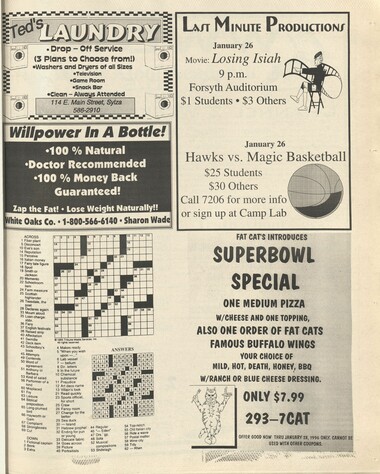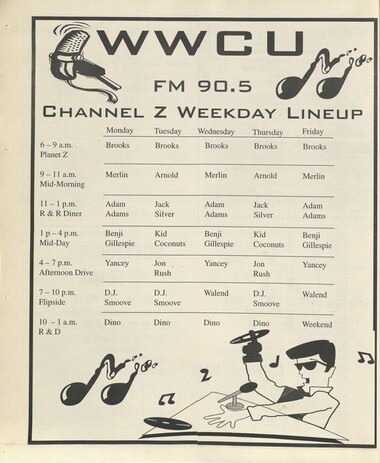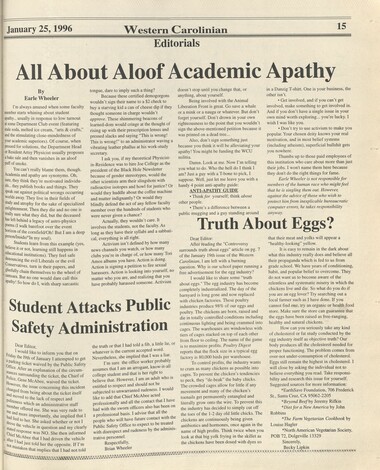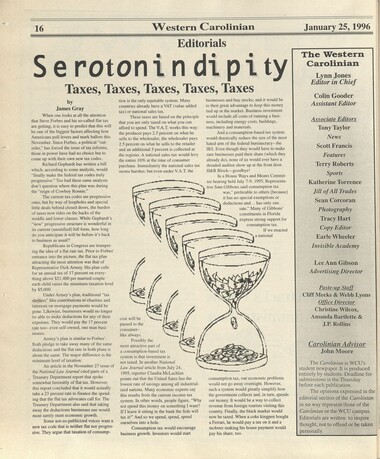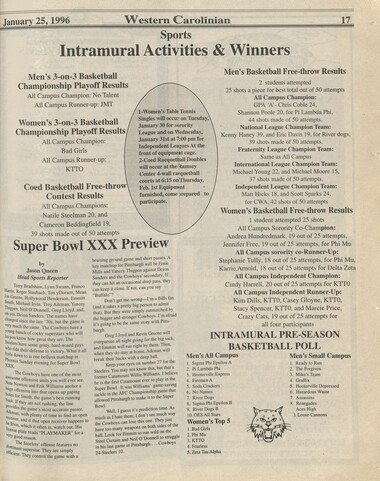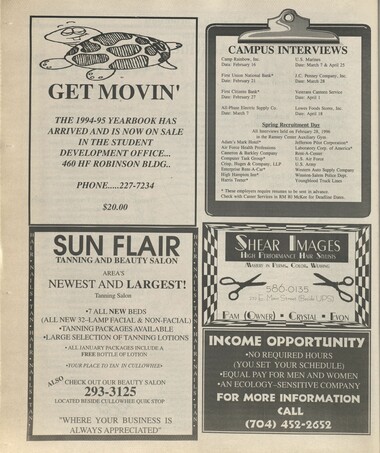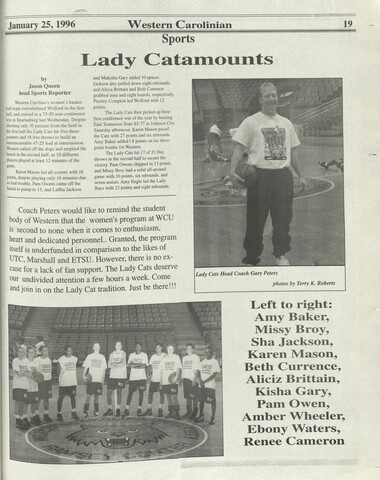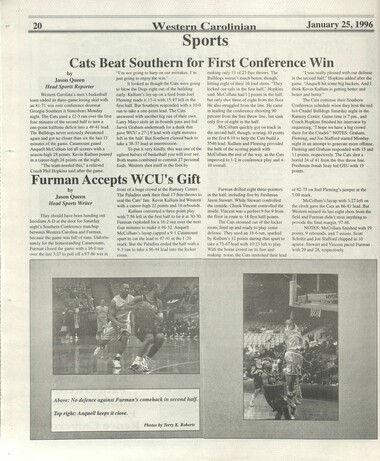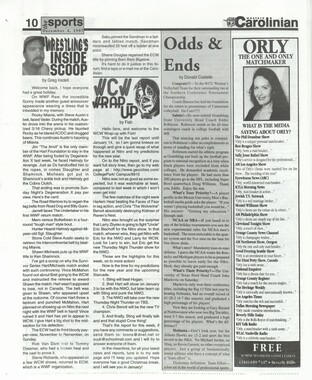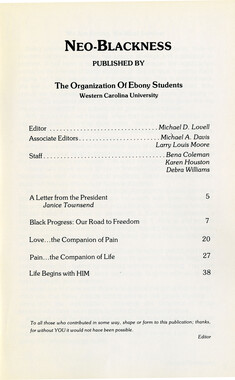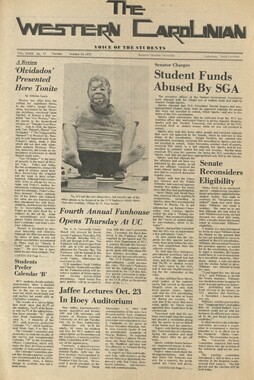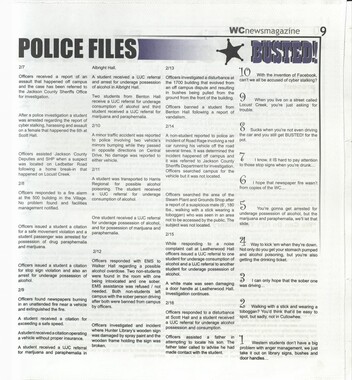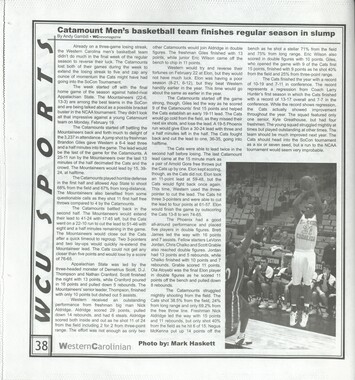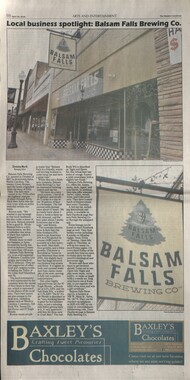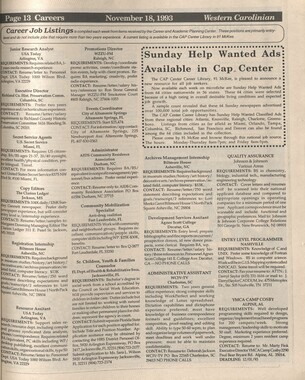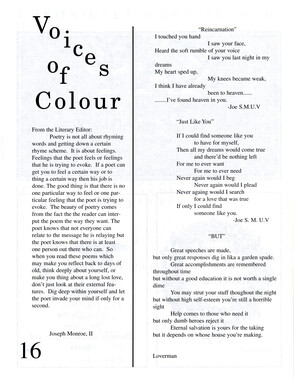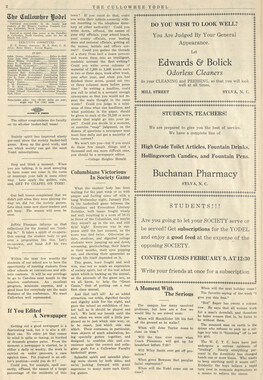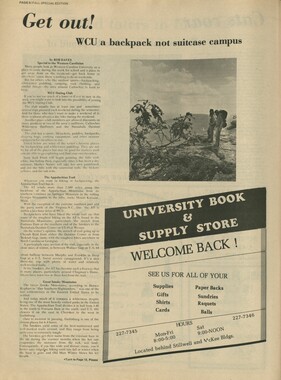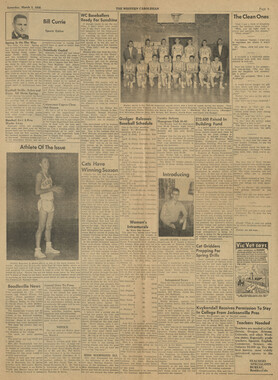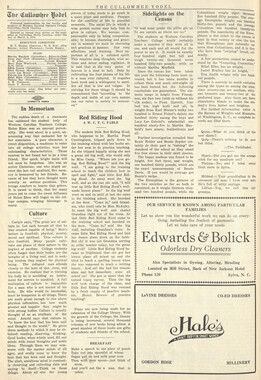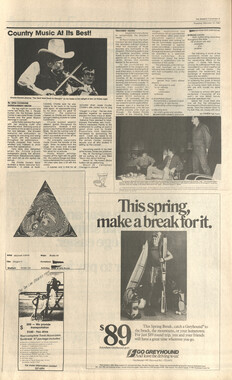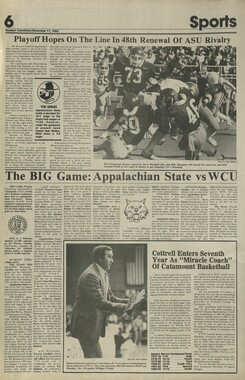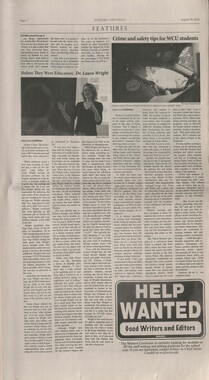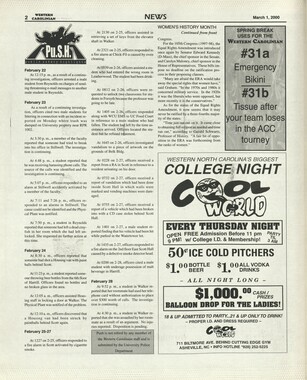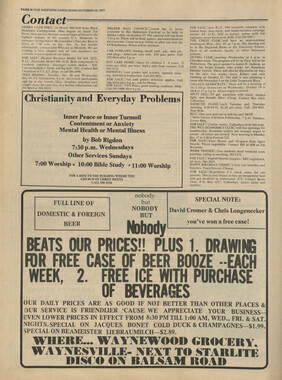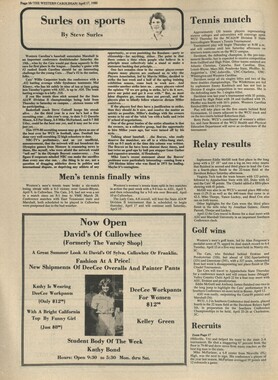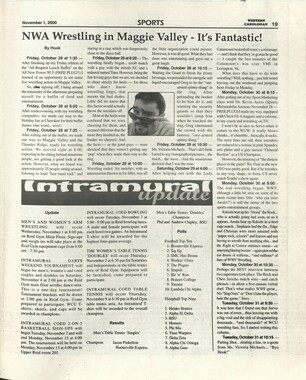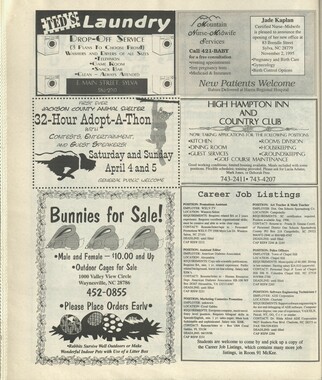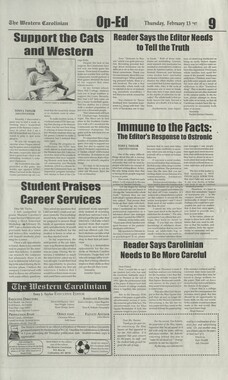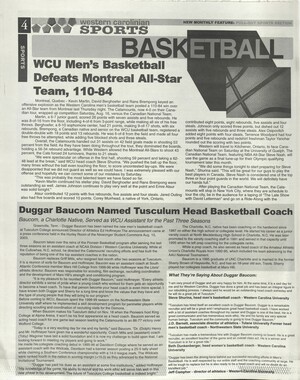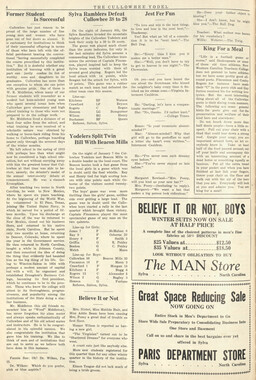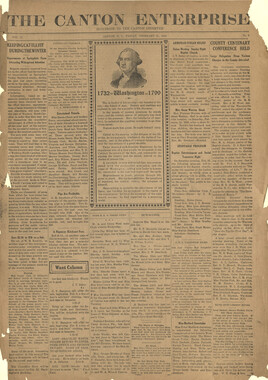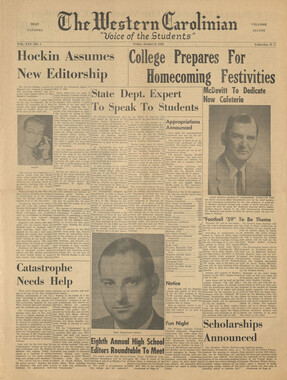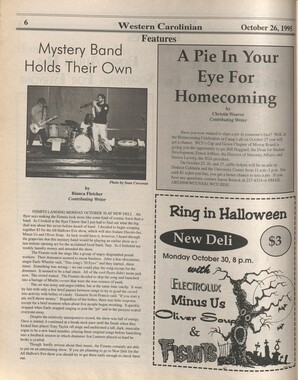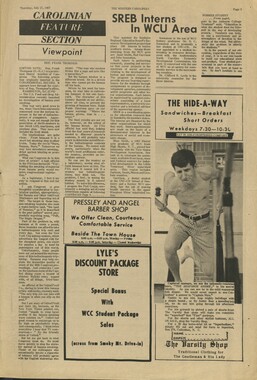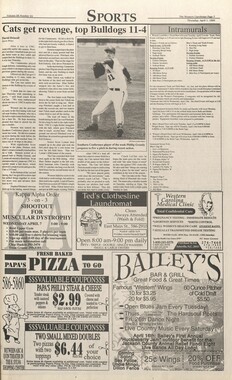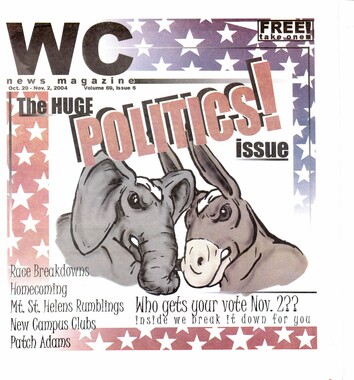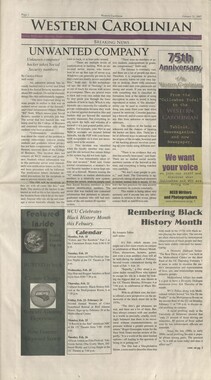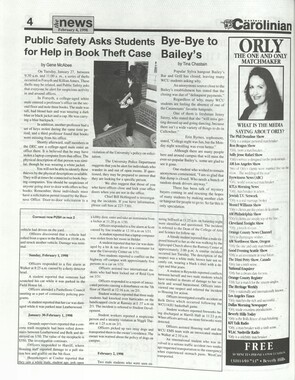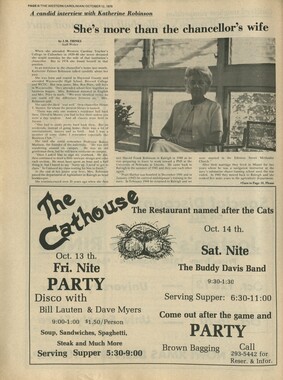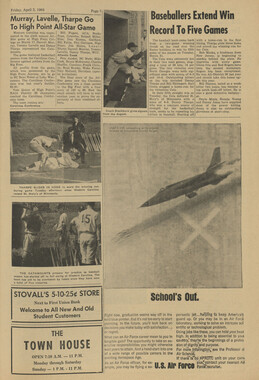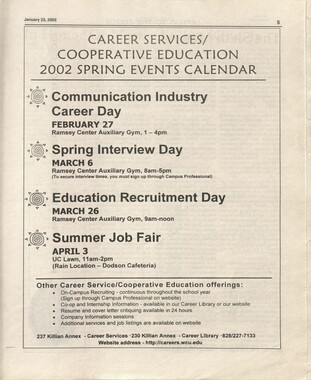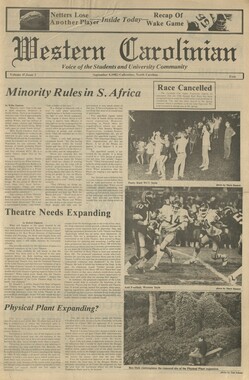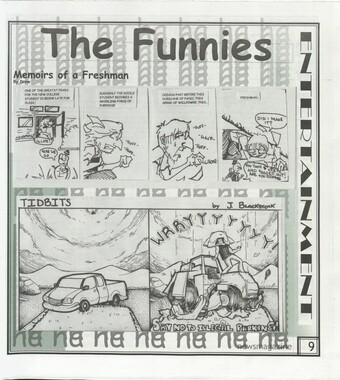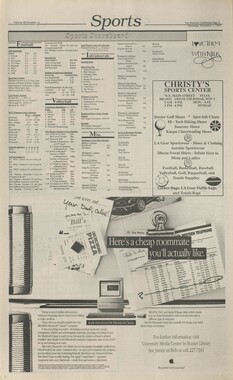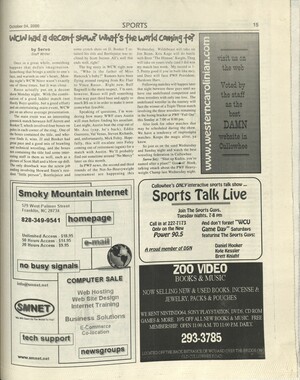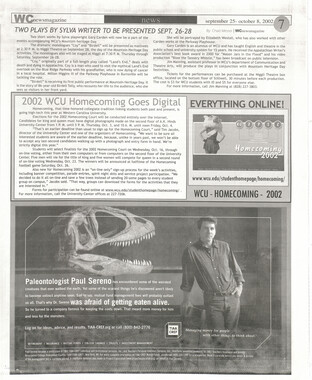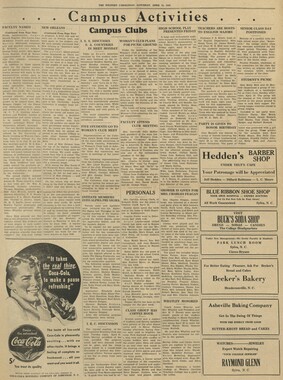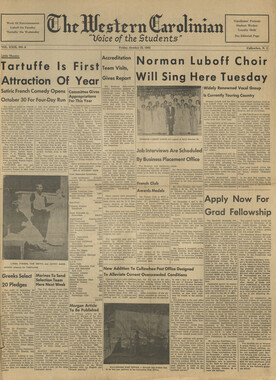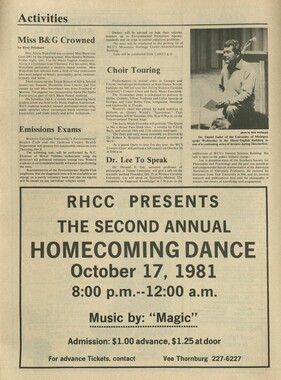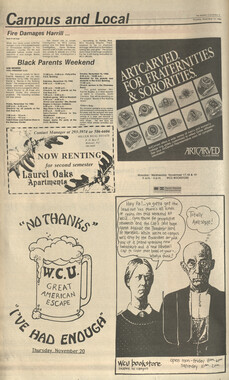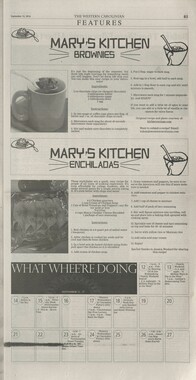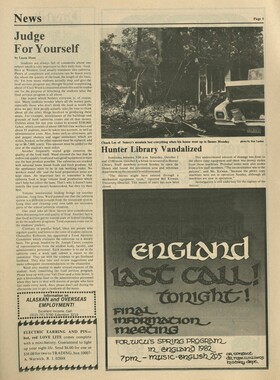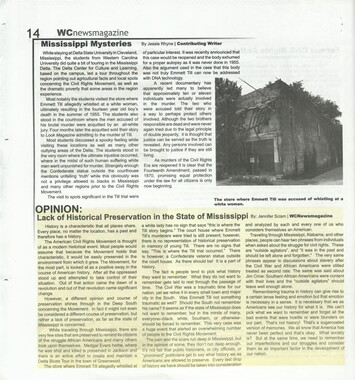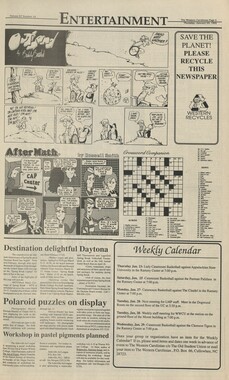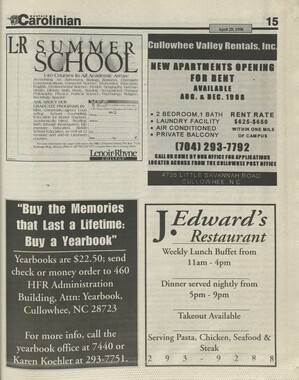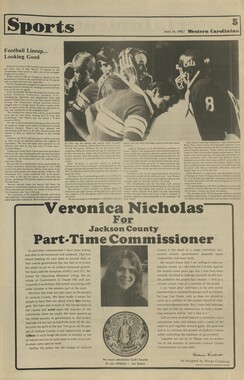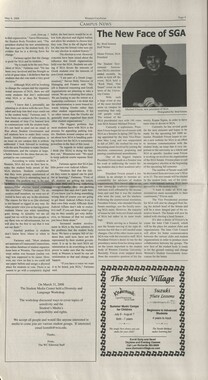Western Carolina University (20)
View all
- Canton Champion Fibre Company (2308)
- Cherokee Traditions (291)
- Civil War in Southern Appalachia (165)
- Craft Revival (1942)
- Great Smoky Mountains - A Park for America (2946)
- Highlights from Western Carolina University (430)
- Horace Kephart (941)
- Journeys Through Jackson (159)
- LGBTQIA+ Archive of Jackson County (85)
- Oral Histories of Western North Carolina (314)
- Picturing Appalachia (6873)
- Stories of Mountain Folk (413)
- Travel Western North Carolina (160)
- Western Carolina University Fine Art Museum Vitreograph Collection (129)
- Western Carolina University Herbarium (92)
- Western Carolina University: Making Memories (738)
- Western Carolina University Publications (2491)
- Western Carolina University Restricted Electronic Theses and Dissertations (146)
- Western North Carolina Regional Maps (71)
- World War II in Southern Appalachia (131)
University of North Carolina Asheville (6)
View all
- Allanstand Cottage Industries (62)
- Appalachian National Park Association (53)
- Bennett, Kelly, 1890-1974 (1463)
- Berry, Walter (76)
- Brasstown Carvers (40)
- Carver, George Washington, 1864?-1943 (26)
- Cathey, Joseph, 1803-1874 (1)
- Champion Fibre Company (233)
- Champion Paper and Fibre Company (297)
- Cherokee Indian Fair Association (16)
- Cherokee Language Program (22)
- Crowe, Amanda (40)
- Edmonston, Thomas Benton, 1842-1907 (7)
- Ensley, A. L. (Abraham Lincoln), 1865-1948 (275)
- Fromer, Irving Rhodes, 1913-1994 (70)
- George Butz (BFS 1907) (46)
- Goodrich, Frances Louisa (120)
- Grant, George Alexander, 1891-1964 (96)
- Heard, Marian Gladys (60)
- Kephart, Calvin, 1883-1969 (15)
- Kephart, Horace, 1862-1931 (313)
- Kephart, Laura, 1862-1954 (39)
- Laney, Gideon Thomas, 1889-1976 (439)
- Masa, George, 1881-1933 (61)
- McElhinney, William Julian, 1896-1953 (44)
- Niggli, Josephina, 1910-1983 (10)
- North Carolina Park Commission (105)
- Osborne, Kezia Stradley (9)
- Owens, Samuel Robert, 1918-1995 (11)
- Penland Weavers and Potters (36)
- Roberts, Vivienne (15)
- Roth, Albert, 1890-1974 (142)
- Schenck, Carl Alwin, 1868-1955 (1)
- Sherrill's Photography Studio (2565)
- Southern Highland Handicraft Guild (127)
- Southern Highlanders, Inc. (71)
- Stalcup, Jesse Bryson (46)
- Stearns, I. K. (213)
- Thompson, James Edward, 1880-1976 (226)
- United States. Indian Arts and Crafts Board (130)
- USFS (683)
- Vance, Zebulon Baird, 1830-1894 (1)
- Weaver, Zebulon, 1872-1948 (58)
- Western Carolina College (230)
- Western Carolina Teachers College (282)
- Western Carolina University (2008)
- Western Carolina University. Mountain Heritage Center (18)
- Whitman, Walt, 1819-1892 (10)
- Wilburn, Hiram Coleman, 1880-1967 (73)
- Williams, Isadora (3)
- Cain, Doreyl Ammons (0)
- Crittenden, Lorraine (0)
- Rhodes, Judy (0)
- Smith, Edward Clark (0)
- Appalachian Region, Southern (2693)
- Asheville (N.C.) (1936)
- Avery County (N.C.) (26)
- Blount County (Tenn.) (195)
- Buncombe County (N.C.) (1672)
- Cherokee County (N.C.) (283)
- Clay County (N.C.) (556)
- Graham County (N.C.) (236)
- Great Smoky Mountains National Park (N.C. and Tenn.) (519)
- Haywood County (N.C.) (3569)
- Henderson County (N.C.) (70)
- Jackson County (N.C.) (4913)
- Knox County (Tenn.) (35)
- Knoxville (Tenn.) (13)
- Lake Santeetlah (N.C.) (10)
- Macon County (N.C.) (420)
- Madison County (N.C.) (215)
- McDowell County (N.C.) (39)
- Mitchell County (N.C.) (132)
- Polk County (N.C.) (35)
- Qualla Boundary (982)
- Rutherford County (N.C.) (76)
- Swain County (N.C.) (2182)
- Transylvania County (N.C.) (270)
- Watauga County (N.C.) (12)
- Waynesville (N.C.) (86)
- Yancey County (N.C.) (72)
- Aerial Photographs (3)
- Aerial Views (60)
- Albums (books) (4)
- Articles (1)
- Artifacts (object Genre) (228)
- Bibliographies (1)
- Biography (general Genre) (2)
- Cards (information Artifacts) (38)
- Clippings (information Artifacts) (191)
- Copybooks (instructional Materials) (3)
- Crafts (art Genres) (622)
- Depictions (visual Works) (21)
- Design Drawings (1)
- Drawings (visual Works) (185)
- Envelopes (73)
- Exhibitions (events) (1)
- Facsimiles (reproductions) (1)
- Fiction (general Genre) (4)
- Financial Records (12)
- Fliers (printed Matter) (67)
- Glass Plate Negatives (381)
- Guidebooks (2)
- Internegatives (10)
- Interviews (815)
- Land Surveys (102)
- Letters (correspondence) (1013)
- Manuscripts (documents) (618)
- Maps (documents) (177)
- Memorandums (25)
- Minutes (administrative Records) (59)
- Negatives (photographs) (6090)
- Newsletters (1290)
- Newspapers (2)
- Notebooks (8)
- Occupation Currency (1)
- Paintings (visual Works) (1)
- Pen And Ink Drawings (1)
- Periodicals (193)
- Personal Narratives (10)
- Photographs (12976)
- Plans (maps) (1)
- Poetry (5)
- Portraits (4568)
- Postcards (329)
- Programs (documents) (181)
- Publications (documents) (2443)
- Questionnaires (65)
- Relief Prints (26)
- Sayings (literary Genre) (1)
- Scrapbooks (282)
- Sheet Music (2)
- Slides (photographs) (402)
- Songs (musical Compositions) (2)
- Sound Recordings (796)
- Specimens (92)
- Speeches (documents) (18)
- Tintypes (photographs) (8)
- Transcripts (322)
- Video Recordings (physical Artifacts) (23)
- Text Messages (0)
- A.L. Ensley Collection (275)
- Appalachian Industrial School Records (7)
- Appalachian National Park Association Records (336)
- Axley-Meroney Collection (2)
- Bayard Wootten Photograph Collection (20)
- Bethel Rural Community Organization Collection (7)
- Blumer Collection (5)
- C.W. Slagle Collection (20)
- Canton Area Historical Museum (2110)
- Carlos C. Campbell Collection (462)
- Cataloochee History Project (64)
- Cherokee Studies Collection (4)
- Daisy Dame Photograph Album (5)
- Daniel Boone VI Collection (1)
- Doris Ulmann Photograph Collection (112)
- Elizabeth H. Lasley Collection (1)
- Elizabeth Woolworth Szold Fleharty Collection (4)
- Frank Fry Collection (95)
- George Masa Collection (173)
- Gideon Laney Collection (452)
- Hazel Scarborough Collection (2)
- Hiram C. Wilburn Papers (28)
- Historic Photographs Collection (236)
- Horace Kephart Collection (861)
- Humbard Collection (33)
- Hunter and Weaver Families Collection (1)
- I. D. Blumenthal Collection (4)
- Isadora Williams Collection (4)
- Jesse Bryson Stalcup Collection (47)
- Jim Thompson Collection (224)
- John B. Battle Collection (7)
- John C. Campbell Folk School Records (80)
- John Parris Collection (6)
- Judaculla Rock project (2)
- Kelly Bennett Collection (1482)
- Love Family Papers (11)
- Major Wiley Parris Civil War Letters (3)
- Map Collection (12)
- McFee-Misemer Civil War Letters (34)
- Mountain Heritage Center Collection (4)
- Norburn - Robertson - Thomson Families Collection (44)
- Pauline Hood Collection (7)
- Pre-Guild Collection (2)
- Qualla Arts and Crafts Mutual Collection (12)
- R.A. Romanes Collection (681)
- Rosser H. Taylor Collection (1)
- Samuel Robert Owens Collection (94)
- Sara Madison Collection (144)
- Sherrill Studio Photo Collection (2558)
- Smoky Mountains Hiking Club Collection (616)
- Stories of Mountain Folk - Radio Programs (374)
- The Reporter, Western Carolina University (510)
- Venoy and Elizabeth Reed Collection (16)
- WCU Gender and Sexuality Oral History Project (32)
- WCU Mountain Heritage Center Oral Histories (25)
- WCU Oral History Collection - Mountain People, Mountain Lives (71)
- WCU Students Newspapers Collection (1923)
- Western North Carolina Tomorrow Black Oral History Project (69)
- William Williams Stringfield Collection (2)
- Zebulon Weaver Collection (109)
- African Americans (390)
- Appalachian Trail (35)
- Artisans (521)
- Cherokee art (84)
- Cherokee artists -- North Carolina (10)
- Cherokee language (21)
- Cherokee pottery (101)
- Cherokee women (208)
- Church buildings (190)
- Civilian Conservation Corps (U.S.) (111)
- College student newspapers and periodicals (2012)
- Dams (107)
- Dance (1023)
- Education (222)
- Floods (61)
- Folk music (1015)
- Forced removal, 1813-1903 (2)
- Forest conservation (220)
- Forests and forestry (1195)
- Gender nonconformity (4)
- Great Smoky Mountains National Park (N.C. and Tenn.) (181)
- Hunting (45)
- Landscape photography (25)
- Logging (119)
- Maps (83)
- Mines and mineral resources (8)
- North Carolina -- Maps (18)
- Paper industry (38)
- Postcards (255)
- Pottery (135)
- Railroad trains (72)
- Rural electrification -- North Carolina, Western (3)
- School integration -- Southern States (2)
- Segregation -- North Carolina, Western (5)
- Slavery (5)
- Sports (452)
- Storytelling (243)
- Waterfalls -- Great Smoky Mountains (N.C. and Tenn.) (66)
- Weaving -- Appalachian Region, Southern (280)
- Wood-carving -- Appalachian Region, Southern (328)
- World War, 1939-1945 (173)
Western Carolinian Volume 61 Number 13
Item
Item’s are ‘child’ level descriptions to ‘parent’ objects, (e.g. one page of a whole book).
-
-
Western Carolinian January 25,1996 News Are College Freshman Apathetic About Politics? Jason Enzler, a freshman at National Catholic University in Washington, says he expected students to be more interested in politics. Instead he sees a lot of apathy on his campus. According to a newly released survey of college freshman, Enzler's experience is not unusual. Today's college freshmen report they have little passion for social issues and political reform, while rising numbers say they believe individuals are powerless to make a difference in society. Researchers at University of California at Los Angeles' Higher Education Research Institute found students who consider "keeping up with political affairs" one of their life's goals dropped this year to an all-time low of 28.5 percent. The high, 57.8 percent, was reached in 1966. "This continuing erosion of students' political interest should be a red flag to all of us who believe in the democratic process," said survey director Alexander Astin, professor at UCLA's Graduate School of Education & Information Studies. "Apparently, increasing political apathy goes hand- in-hand with disengagement from social action and a growing sense of powerless- ness." Fewer of today's freshmen cared about "influencing social values" (38.2 percent as opposed to 43.3 percent in 1992), "cleaning up the environment" (22.5 percent from 33.6 percent), "influencing the political structure" (17.2 percent from 20.1 percent), "promoting racial understanding" (33.4 percent from 42 percent), and "participating in a community action program" (23 percent from 26.1 percent). And, the percentage of freshmen who think one person "can do little to change society" rose to nearly 34 percent—a 10- year high, said surveyors. Predictably, the number of students who discuss politics frequently was also at the lowest point ever: 14.8 percent. The fall survey, sponsored by the American Council on Education, was given to 323,791 entering freshman at 641 two- year and four-year institutions. Of these, 240,083 questionnaires from 437 college and universities were used. The institute then weighted the data in an effort to make it reflective of the views of the. nation's 1.5 million college freshman. Kazim Ali, vice president of the United States Students Association (USSA), said there has been a wave of activism among students this year who are battling federal student aid cuts or campaigning for the restoration of affirmative action policies within the University of California system. But, he added, he's not surprised if students feel as if the political system isn't working for them. "Students were courted by one political party, then another, and no one has delivered on their promises. No wonder students have become disillusioned," Ali said. "Look at the national political scene. What role models do students have in the American political system?" In 1992, a record number of students voted in the election, with 29 percent of President Clinton's support coming from 18- to 24-year-olds. Ali said MTV's Rock the Vote and the Clinton campaign were both successful in convincing young people to get out and vote. "But nothing panned out," he added. "Issues that mattered to young people—universal health care, lifting the ban on gays in the military—have been taken away. Now as Congress continues to chip away at direct lending, students are becoming more disenchanted." At the same time, more freshmen students are describing their political values as "middle of the road" (54.3 percent) than in recent years. And while those who called themselves "liberal" or "conservative" decreased, those who labeled themselves belonging to the "far left" (2.7 percent) and the "far right" (1.6 percent) reached all-time highs. "For the first time in the history of the survey, we have a situation where the large majority of young people are moving toward the center at the same time the small minorities at the extremes are growing," Astin said. These "middle-of-the-road" values are moving students in two directions on social issues. They are becoming more conservative about support for sexual and reproductive freedoms.This year, 58.4 percent want to keep abortion legal as opposed to 64.9 percent in 1990; even fewer (42.7 percent) advocate sex between people who "have known each other for a very short time." "There are more diseases and stuff.. And I just don't think people want to sleep with the first person they meet. They want to get to know them better," said Dennise Ledesma, an 18-year-old freshman at California State University, in an Associated Press report. On the liberal side, the belief that homosexual relationships should be prohibited has declined to an all-time low of 30.6 percent. And support for legalizing marijuana reached a 15-year high of 33.8 percent. Although most college freshmen think race should be given special consideration in college admissions, only half answering an annual survey disagreed with the statement, "Affirmative action in college admissions should be abolished." Researchers found that 70 percent surveyed in its 30th national report said race should be given at least "some special consideration" by admissions officers. Students were split 50-50, though, when the question contained the words "affirmative action." "This discrepancy highlights the fact that people are willing to support the consideration of race in admissions, but are less willing to commit themselves to the more politically loaded phrase 'affirmative action,' " said Linda Sax, the survey's associate director. Support for race-based admissions was greatest at historically black colleges and universities (90.3 percent) and lowest at four-year universities (65 percent); opinions held no matter which racial or ethnic group was being considered and whether students surveyed attended public or private schools. "Despite widespread attacks on affirmative action, college freshmen—the very people who most recently experienced the admissions process—support the use of diverse criteria in admissions," Sax said. In addition to race, freshmen also said admissions directors should consider academic achievement (96.1 percent), economic background (96 percent), athletic ability (84.5 percent) and citizenship status (86.4 percent). More than half, or 58.3 percent, also think children of alumni should get special consideration. More freshmen (9.7 percent) also intend to pursue education careers than in the previous two decades. Interest in studying engineering and law, meanwhile, fell to its lowest points (6.4 percent and 3.4 percent, respectively). Students reported that during their senior years of high school, that they spent increasingly less time on academics and more time exercising, playing sports or working at part-time jobs. More than three- fourths (77 percent) spent six or more hours each week socializing, while 62.7 percent worked more than six hours a week. The increased time spent working in high school may reflect students' overwhelming concern (71.4 percent) that they have enough money to finish college. With students receiving less financial assistance from their families and government aid drying up, freshmen increasingly relied on loans to pay their school bills. Nearly 40 percent said they will have to get a job to help cover expenses. Enzler says he and other freshmen like him worry about how they will come up with the cash to pay for school. But, he said, he doesn't let it get him upset. "I worry about it, but I figure I'll be making a lot of money when I get out." He has some loan and scholarship money from the school in addition to a work-study job. Freshmen women reported that they were twice as likely as their male counterparts to feel "overwhelmed" by their college responsibilities. They were more likely to spend one to five hours a week studying, participating in student groups, taking care of children or households, performing volunteer work and talking with professors. Freshmen men, on the other hand, more frequently reported spending six or more hours a week exercising, partying and watching television. Contributed by College Press Service Sigma Nu Anniversary by J. Leatherwood Staff Reporter Sigma Nu fraternity celebrated their first decade at Western Carolina University in a recent weekend event that united alumni with their younger counterparts. November 9, 1995 marked the tenth anniversary since the Greek colony Gamma Sigma Nu received a charter making them an official WCU fraternity. The following weekend consisted of a banquet at the Ramsey Center, a party with live music, and a golf tournament. Mike Hupfauer, a senior and Sigma Nu treasurer, reported that between 60 and 75 people attended. 'We would have had more," he said, "but Homecoming and our anniversary came so close together that some of our brothers had to choose between them when they took off from work." According to Hupfauer, the older Sigma Nu brothers were better golf players. "They won the tournament hands down. I guess they have more time to practice their swing," he remarked. The alumni concluded their visit with a speeches, and sentiments seemed to be good between fraternal members. Sigma Nu fraternity was founded in 1869 at the Virginia Military Institute and has more than 200 college
Object
Object’s are ‘parent’ level descriptions to ‘children’ items, (e.g. a book with pages).
-
The Western Carolinian is Western Carolina University's student-run newspaper. The paper was published as the Cullowhee Yodel from 1924 to 1931 before changing its name to The Western Carolinian in 1933.
-
